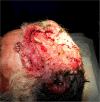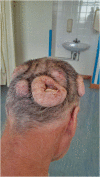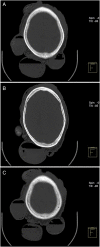Extensive and ulcerated malignant proliferating trichilemmal (pilar) tumour, arising from multiple, large, degenerated trichilemmal (pilar) cysts
- PMID: 26857582
- PMCID: PMC4746509
- DOI: 10.1136/bcr-2015-209785
Extensive and ulcerated malignant proliferating trichilemmal (pilar) tumour, arising from multiple, large, degenerated trichilemmal (pilar) cysts
Abstract
We report a rare case of a 61-year-old homeless man with a 15-year history of multiple trichilemmal cysts that served as a forerunner for the emergence of a malignant proliferating pilar tumour. The patient presented multiple, large, purulent, ulcerated lesions ranging from 10 to 150 mm in diameter, covering most of the scalp, with large areas superimposed by extensive myiasis infestation. The patient presented with no other major clinical findings. A CT scan showed no detectable signs of local or distant metastatic invasion. Initial supportive treatment was implemented. Given the extent of the injury, further surgical excision was considered, which required transfer to a specialised surgical centre. This social case is of educational value, as it can raise clinician awareness about the ability of trichilemmal cysts to undergo malignant transformation. Additionally, it highlights the importance of adequate social assistance structures for patients in need.
2016 BMJ Publishing Group Ltd.
Figures






References
-
- Weedon D, Strutton G, Rubin AI. Weedon's skin pathology. 3rd edn Edinburgh: Churchill Livingstone/Elsevier, 2010:444.
Publication types
MeSH terms
Supplementary concepts
LinkOut - more resources
Full Text Sources
Other Literature Sources
Medical
